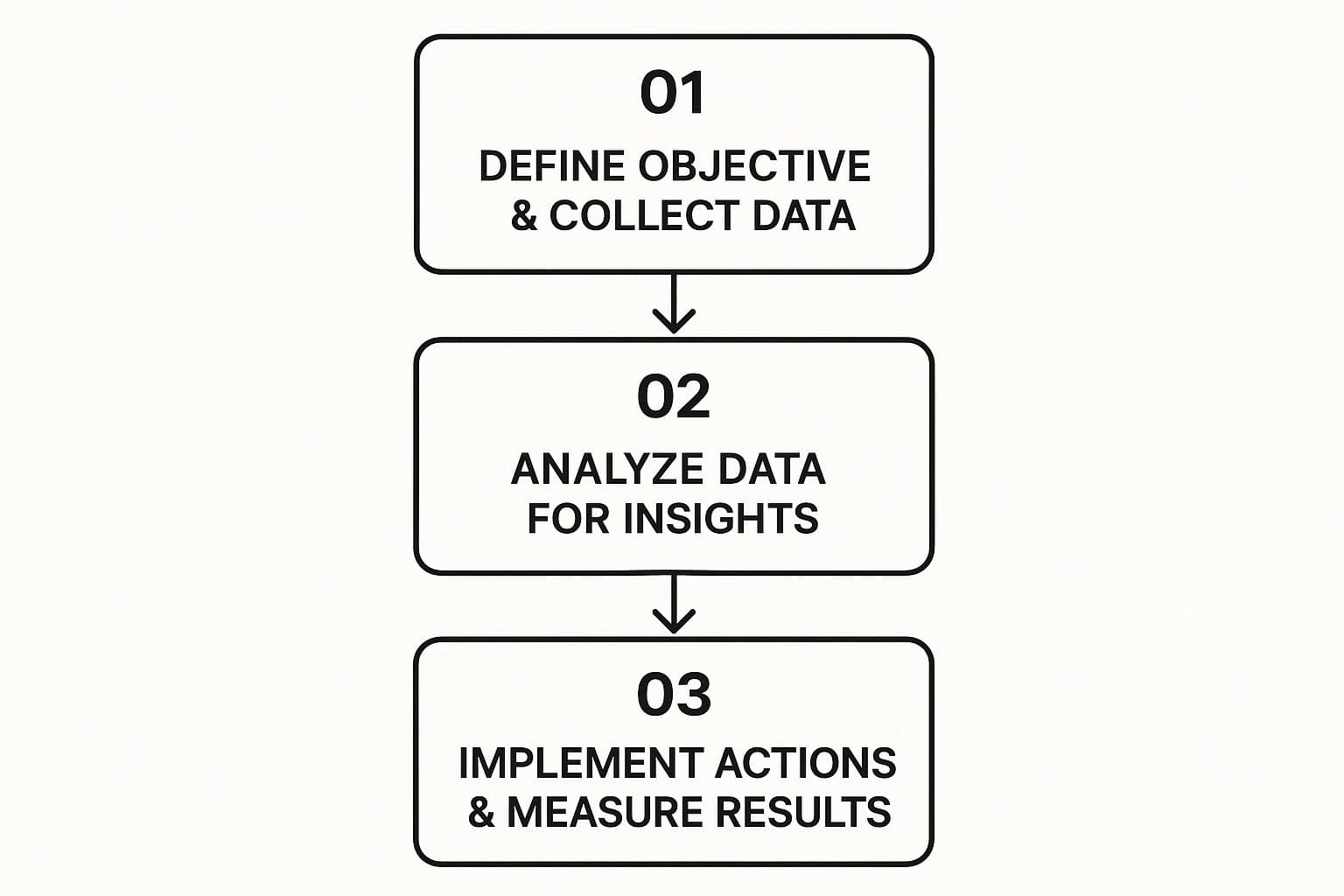Let's get right to it. At its heart, data-driven decision making (DDDM) is about making strategic choices based on hard evidence, not just a hunch. It’s the difference between guessing and knowing.
Imagine a ship captain setting a course. An old-school captain might rely on the feel of the wind and a "gut feeling" about the currents. A data-driven captain, however, pulls out the maps, checks detailed weather forecasts, and uses sonar readings to chart the safest, most efficient route. Both might reach a destination, but one has a much higher chance of success.
What Is Data Driven Decision Making Really?

More than just a process, adopting data-driven decision making is a fundamental shift in company culture. It’s about moving your team from saying, "I think this will work," to a much more powerful statement: "The data shows this is our best path forward."
This simple change helps you sidestep the common traps of personal bias, incorrect assumptions, and emotional responses that can lead to costly mistakes.
Instead of basing big decisions on a single story or simply doing what's always been done, teams actively gather and analyze relevant information. They look for patterns, uncover facts, and pull out key insights that form a solid foundation for every strategic move, whether it's launching a new product, refining a marketing campaign, or improving internal operations.
Shifting From Gut Feel To Hard Facts
Let's break down the core difference between the old way of doing things and the new, data-backed approach.
Traditional vs Data Driven Decision Making
The table below shows a direct comparison, highlighting the core differences in approach, inputs, and outcomes.
This table makes it clear: one path relies on subjective feelings, while the other is built on objective reality.
This doesn't mean human experience becomes useless—far from it. The goal is to blend expert intuition with objective data. This creates a powerful combination where hard numbers guide the strategy, and human experience helps interpret what those numbers truly mean.
And the numbers back this up. Research shows that companies who truly embrace data-driven practices blow their competitors out of the water. They are 23 times more likely to acquire customers, 6 times more likely to retain those customers, and 19 times more likely to be profitable. You can dig into the full findings on why data-driven enterprises succeed to see just how big the advantage is.
This isn't just a job for the data science team. It's a mindset that gives everyone—from marketing to operations—the confidence to answer tough questions and innovate effectively.
Key Benefits of Making Decisions with Data

Shifting to a data-first mindset is about more than just making prettier charts. It’s about getting real, measurable results that show up on the bottom line. You start to see a boost in confidence, efficiency, and your overall position in the market.
When you ground your choices in solid evidence, you're essentially swapping guesswork for certainty. This empowers your team to make bold moves with conviction because they're backed by proof, not just a strong opinion. The endless debates about what might work are replaced by a unified strategy based on what the data shows.
This naturally leads to more accurate and consistent results. Data shows you what’s really moving the needle, so you can double down on what works and stop repeating the same old mistakes.
Drive Smarter Operations and Innovation
One of the first things you'll notice is a big jump in operational efficiency. By digging into your performance metrics, you can spot hidden bottlenecks, cut out wasteful spending, and fine-tune your workflows. It’s like getting a detailed blueprint of your business, showing you exactly where to make the best improvements.
This clarity doesn’t just apply to your internal processes; it gives you a direct window into your customers' world. You get a much clearer picture of their behaviors, needs, and frustrations.
- Deeper Customer Understanding: Sift through purchase histories and engagement patterns to figure out what people actually want from you.
- Personalized Experiences: Use insights to customize marketing messages and product recommendations, which is a huge driver of customer loyalty.
- Proactive Problem-Solving: Spot negative trends in customer feedback early on and fix issues before they escalate into major problems.
Gain a Lasting Competitive Edge
At the end of the day, making decisions with data gives you a serious leg up on the competition. While others are still relying on gut feelings, you’re making moves based on facts. This helps you innovate faster, adapt more quickly to market changes, and put your money where it will have the most impact.
By rooting your strategy in concrete evidence, you sharpen your return on investment (ROI) and build a more resilient, forward-thinking company. You’re no longer just trying to keep up—you’re setting the pace.
An Actionable Framework for Data-Driven Decisions
Knowing that data-driven decisions are good for business is one thing. Actually making them is another. To get started, it helps to have a clear, repeatable framework to follow. Think of it as a roadmap that turns raw information into a real strategy, guiding you from a simple question to a result you can actually measure.
It’s a bit like baking a cake. You wouldn't just toss random ingredients into a bowl and hope for the best. You follow a recipe—measuring, mixing, and baking in a specific order—to get something delicious and predictable. This framework does the same for your business decisions, bringing structure to what can often feel like a chaotic process.
Let's walk through the core steps with a real-world example: imagine you're a retail manager trying to figure out why weekend sales have suddenly tanked.
Define Your Objective and Collect Data
First things first, you need to know what you’re trying to solve. A vague goal like "improve sales" is too fuzzy to be useful. You need to get specific and measurable, like this: "Identify the root cause of the 15% drop in weekend in-store sales over the last month."
Now that’s a clear question. It tells you exactly what data you need to hunt down. The manager would start gathering relevant info from a few different places:
- Sales Data: Transaction records, average purchase value, and sales numbers by product category for the last three months.
- Website Analytics: Is there a spike in online shopping on weekends that might explain the in-store dip?
- Customer Feedback: Recent reviews or survey responses that mention the weekend shopping experience.
- Staff Observations: Notes from employees on the floor about foot traffic, customer behavior, or anything else that seems out of the ordinary on weekends.
This infographic breaks down the simple, three-stage loop for making data-driven decisions.

As you can see, the process is a continuous cycle. It always starts with a clear objective and ends with measuring your results, which then informs the next decision you make.
Analyze Data to Find Insights
With all the data collected, it's time to start looking for patterns. This isn’t about running complex statistical models; it’s about connecting the dots. Our manager might notice that while overall sales are down, one category—home goods—has taken a nosedive, but only on Saturdays. At the same time, notes from the staff mention that a popular new farmers' market just opened a block away, and it runs every Saturday morning.
This move from gut feelings to evidence-based strategy is becoming the norm. In fact, research shows that 44% of global organizations already rely on data for most decisions, and another 25% base nearly all their strategic choices on it. This shift away from pure intuition is massive. You can dig deeper into the global trend of data-driven organizations to see just how quickly businesses are adapting.
Implement Actions and Measure Results
Armed with a solid insight, the manager can now form a hypothesis: "If we run a special 'post-market' promotion on Saturday afternoons, we can win back that foot traffic."
The final steps are to act on this idea and see if it works:
- Implement: They launch a targeted social media campaign and put up in-store signs advertising a 20% discount on all home goods from 1 PM to 4 PM on Saturdays.
- Measure: For the next four Saturdays, they closely track sales figures and foot traffic during the promotion hours.
- Iterate: The new data shows a 12% increase in Saturday afternoon sales, almost making up for the initial drop. The solution is working.
This cycle—define, collect, analyze, and act—is the heart of making smart decisions. It's also a fundamental part of building an organization that learns and adapts. If you're curious about how companies organize these kinds of insights, you might find our guide on what is knowledge management helpful.
Overcoming Common Data Implementation Challenges
Switching to a data-driven culture sounds straightforward, but let's be honest—it rarely is. Even companies with the best intentions hit common roadblocks that can stall their momentum. Knowing what these hurdles are ahead of time is the best way to get past them.
For many teams, the first trip-up is poor data quality. The information you need might be incomplete, wrong, or siloed in different departments using formats that don't talk to each other. It’s like trying to bake a cake when your ingredients are mislabeled and spread all over the house.
Another big one is the skills gap. Your team might not feel confident or have the right training to work with data. This often creates a bottleneck where only a handful of "data people" can run analyses, which keeps the rest of the organization from truly embracing a data-first mindset.
Dealing with Data Quality and Skills Gaps
When you're facing messy data, don't try to fix everything at once. Start small. Pick one manageable project with a single, clean data source to work with. This lets you score a quick win and builds momentum for bigger, more complex projects later on. For instance, you could start by analyzing your website traffic before diving into the messier task of combining it with sales records.
To close the skills gap, focus on empowerment, not just training. Give your teams access to user-friendly tools and dashboards that don't require an advanced degree to operate. Short, practical training sessions that show people how to answer their own questions with data can make a world of difference. The goal is to make data approachable, not intimidating.
Overcoming Cultural Resistance
The toughest hurdle is often cultural resistance. People get comfortable with the way things have always been done. Shifting to a data-focused approach can feel like a threat to those who've built their careers on intuition and experience. They might see it as a critique of their judgment or just another layer of complexity they don't have time for.
The best way to win over the skeptics is to show, not just tell. Run small pilot projects that solve real, specific problems and deliver undeniable wins. When a data-driven approach finally cracks a long-standing issue or gives a key metric a noticeable boost, it's the most powerful proof you can offer.
It also helps to make sure the insights from meetings and discussions are actually captured and shared. When decisions and action items are clearly documented, you create a transparent record that reinforces the value of having structured information. This is where good documentation habits come in, and you can learn more by checking out these tips on how to take better meeting notes. Building this foundation of shared knowledge is a quiet but critical part of supporting your data initiatives.
How AI Is Changing the Game for Data-Driven Decisions

Artificial intelligence is more than just a tech trend; it’s the engine making data-driven decisions faster and smarter. While older analytics methods were great for looking back at what happened, AI and machine learning are all about predicting what’s coming next.
These systems can tear through enormous amounts of data in a flash, picking out subtle patterns and connections a human could never spot. This allows businesses to stop reacting to the past and start anticipating the future—getting ahead of market trends and customer demands before they fully take shape. It’s like having an army of analysts working 24/7.
This shift is fundamentally changing how companies operate. In fact, many experts believe AI-powered analytics will be standard practice by 2025, making complex data analysis an automated, real-time function. You can read more about how AI will revolutionize decision-making by 2025 on datahubanalytics.com.
Turning Conversations Into Actionable Data
One of the most practical ways AI helps is by making sense of unstructured data. Just think about all the valuable information locked away in everyday conversations—sales calls, internal brainstorms, and customer feedback meetings. For years, these goldmines of insight were nearly impossible to measure and were often forgotten the moment the call ended.
AI tools are flipping that script. They can take spoken words and turn them into organized, searchable data.
- Transcription and Analysis: First, AI accurately transcribes the entire conversation, creating a perfect text record.
- Insight Extraction: Next, it combs through the text to pinpoint key themes, customer feelings, assigned tasks, and important decisions.
- Data Structuring: Finally, it organizes this information with tags and categories, so you can easily search and analyze it later.
This entire process turns messy, everyday dialogue into a structured source of qualitative data, ready to be plugged right into your decision-making process.
Unlocking Deeper Insights from Meetings
Let's look at a real-world example: an AI meeting summarizer. Imagine you just finished a sales demo. The tool can automatically create a summary that pinpoints the customer's biggest problems, budget limitations, and specific feature requests. This is far more than just a time-saver; it’s a data-gathering machine.
Now, multiply that by hundreds of calls. Suddenly, you start seeing powerful trends emerge. You might find that 70% of prospects in a specific sector bring up the same competitor, or that one particular feature is a must-have for your larger clients. That kind of information is pure gold.
This is a key part of what’s known as conversation intelligence. You can learn more by checking out our guide on what is conversation intelligence. By using AI to tap into this constant stream of data, teams can make much smarter choices about product roadmaps, sales tactics, and customer support, all backed by what the market is actually saying.
Your Top Questions About Data-Driven Decision Making, Answered
Knowing what data-driven decision making is one thing, but actually putting it into practice? That's where the real questions start to bubble up. This is where the rubber meets the road.
Let's walk through some of the most common questions teams have when they're just getting started. We'll give you straight, no-fluff answers to help you get moving.
Where Should a Small Business Start with All This?
The secret? Start small. Don't try to analyze your entire business overnight—you'll just get overwhelmed. Instead, pick one single, important business question you want to answer.
What’s a good place to begin? Think about what keeps you up at night.
- Customer Churn: Why do so many customers disappear after their first purchase?
- Website Conversions: What’s the roadblock preventing visitors from signing up for our trial?
- Marketing Budget: Which ad channel is really bringing us the best leads, not just the most clicks?
By zeroing in on one clear problem, you can often use data you already have sitting in your sales CRM or Google Analytics. The goal here is to score a quick, meaningful win. Solving a real problem proves the value of this approach and builds the momentum you’ll need for bigger projects later on.
What Tools Do I Absolutely Need to Get Started?
You don’t need to spend a fortune on fancy software. Honestly, most businesses can get incredibly far with tools they probably already have access to.
A simple, effective starter kit usually includes:


